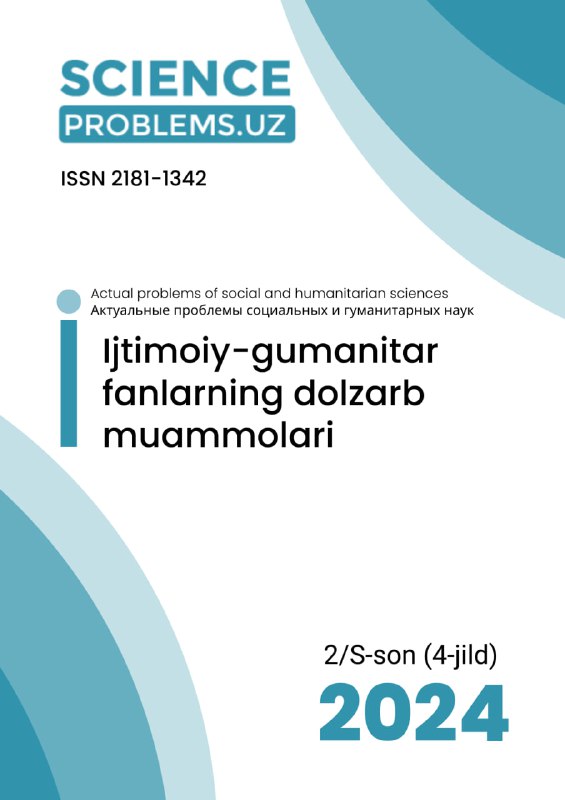TALABALARINING O’QUV FAOLIYATI VA ILMIY IZLANISHLARIDA SUN’IY INTELLEKT: IMKONIYAT VA CHEGARALAR
Kalit so'zlar
https://doi.org/10.47390/SPR1342V4SI2Y2024N54Kalit so'zlar
talaba, sun’iy intellekt, o’quv faoliyati, ilmiy izlanish, tadqiqot faoliyati, chegara, raqamli texnologiya, axloqiy qadriyat.Annotasiya
Maqolada talabalarining o’quv faoliyati va ilmiy izlanishlarida sun’iy intellekt: imkoniyat va chegaralar muammosining nazariy asoslari tahlil qilingan. Sun’iy intellekt tizimidan kundalik hayotda va, xususan, ta’lim sohasida samarali foydalanish imkoniyatlari ko’rsatib o’tilgan. Tahlil natijalariga ko’ra, sun’iy intellektdan foydalanish jarayonida qo’llanilishi kerak bo’lgan axloqiy qadriyatlar tamoyillari tizimlashtirilgan, talabalarining o’quv faoliyati va ilmiy izlanishlarida sun’iy intellektdan foydalanish xususiyatlari aniqlangan. Bundan tashqari, sun’iy intellekt zamonaviy pedagogik mexanizmi sifatida ta’lim va fanning samarali birlashuvi jarayonida muhim konseptual–metodik ahamiyatga ega ekanligi aniqlangan.
Manbalar
Talyzina, N.F. Talabalarning kognitiv faolligini shakllantirish ¬/ N.F. Talyzin. – M .: Bilim, 1983. – 96 b.
Taylaqov U.N. Elektron axborot ta’lim muhitini yaratish texnologiyalari: Monografiya. –T.: O‘zPFITI, 2016, ̶ 152 b.
Бекмурадов К.А., Ишанкулов А., Ганиева Н. Методическое указания к практическим занятиям по курсу «Интеллектуальных систем». Самарканд. 2009.
Weizenbaum J. ELIZA – a computer program for the study of natural language communication between man and machine. In Communication of the ACM. 1966. Vol. 9. No. 1. P. 36–45. DOI: https://doi.org/10.1145/365153.365168
6. Rubin P. A Conversation with Jaron Lanier, VR Juggernaut. The Wired : website. 2017. URL: https:// www.wired.com/story/jaron–lanier–vr–interview/ (Last accessed: 17.05.2023).
Biokibernetyka Mykoly Amosova [Nikolay Amosov’s Bio–cybernetics]. Informatsiini tekhnolohii v Ukraini : istorii ta osobystosti [History of computing in Ukraine]: website. Available at: http://ua.uacomputing.com/stories/nikolay–amosovs–bio–cybernetics (accessed: 25 May 2023).
Hinton G., Osindero S., Teh Y. (2006). A fast learning algorithm for deep belief nets. Neural Computation. Vol. 18. P. 1527–1554. DOI: https://doi.org/10.1162/neco.2006.18.7.1527
Джордж Ф. Люгер. Искусственный интеллект: стратегии и методы решения. 4–е изд. М.: Издательский дом «Вильямс», 2014. С. 864.
Глибовець М. М., Олецький О. В. Штучний інтелект: підручник. Київ: Вид. дім «КМ Академія», 2019. С. 4.
Qarshiyev J. M. Sun’iy intellekt tizimlari yordamida malaka oshirish ta’limi tinglovchilarining kognitiv kompetensiyalarini rivojlantirish. 13.00.01 – Pedagogika nazariyasi. Pedagogik ta’limotlar tarixi. Pedagogika fanlari bo‘yicha falsafa doktori (PhD) ilmiy darajasini olish uchun yozilgan dissertatsiya, Termiz–2023








